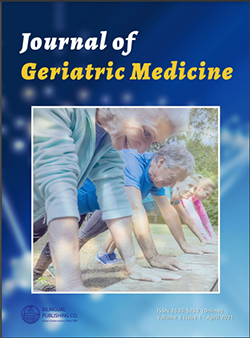 Correction & Withdrawal Policies
Correction & Withdrawal Policies
Hourly Rounding and Fall Prevention among the Elderly in Long Term Care: A change Process
DOI:
https://doi.org/10.30564/jgm.v3i1.2614Abstract
Long term care facilities have a rising rate of falls and fall related injuries with increasing cost and more hospitalization. Hourly rounding® is an evidenced based intervention that is proactive for nursing staff to be able to identify patient’s needs. This helps with positive fall prevention outcome. This project focused on process improvement efforts for 10 weeks and examining the education and implementation of an evidenced-based hourly rounding program that assisted in reducing the number of falls in the pilot unit. The implementation of the intervention took place in a long-term care facility located in Dallas, Georgia. The hourly rounding tools used in this project were the Studer Group hourly rounding log and competency checklist with permission. Twenty staff members were included in the sample, age 18 years and 60 years. The unit has 41 residents who were included in the pilot case study design. Staff members were first educated regarding hourly rounding and documentation on the hourly rounding log was done two days before implementation and the pre and post fall rate was retrieved from the facilities fall database. Competency checklist was completed prior to implementation and post implementation to evaluate staff understanding of the main tenets of the 4 P’s (potty, pain, possession, and position). For this project, descriptive statistics was used to help determine fall rates. Minitab was used to analyzed data and to determine if it was clinically significant. In the ten weeks following the hourly rounding implementation, participants performed hourly rounding by incorporating it to each resident’s daily routine and documented their rounds on the log sheet. The results indicated that it is statistically significant and with a P-values = -<0.0001 and t-value = -5.81.Keywords:
Rounding and education; Fall risk; Fall reduction; Older adult patients; Quality improvement; Fall prevention; Fall and fall related injuryReferences
[1] Centers for Disease Control and Prevention. (2016). Home and recreational safety: costs of falls among older adults. Atlanta, GA: National center for injury prevention and control, division of unintentional injury prevention.
[2] Mitchell, M. D., Lavenberg, J. G., Trotta, R. L., & Umscheid, C. A. (2014). Hourly rounding to improve nursing responsiveness: A systematic review. JONA: The journal of nursing administration, 44(9), 462- 472. DOI:https://doi.org/10.1097/NNA.0000000000000101
[3] Wexler, S., & D’Amico, C. (2015). Creating an environment of falls prevention: Evidence-based practice can reduce falls and fall-related injuries. American Nurse Today, 10(7), 34-35.
[4] Simmons, B. (2010). Clinical reasoning: Concept analysis. Journal of Advanced Nursing 66(5), 1151– 1158. DOI:https://doi.org/10.1111/j.1365-2648.2010.05262.x
[5] Georgia department of health, 2016.Core capacity for injury. Retrieved from dph.georgia.gov/core-capacity-injury on September 10, 2019.
[6] Studer Group. (2007). Best practice: Sacred Heart Hospital Pensacola Florida. Retrieved from https://www.mc.vanderbilt.edu/root/pdfs/nursing/hourly_rounding_supplement-studer_group.pdf.
[7] Rapp, E., Lamb, S. E., Erharbart-Beer, L., Lindemann, U., Rissmann, U., Klenk, J., & Becker, C. (2010). Effect of a statewide fall prevention program on incidence of femoral fractures in residents in long-term-care facilities. The Journal of American Geriatrics Society, 58(1),70-75.
Downloads
How to Cite
Issue
Article Type
License
Copyright © 2021 Joice Anu

This is an open access article under the Creative Commons Attribution-NonCommercial 4.0 International (CC BY-NC 4.0) License.




 Joice A. Anu
Joice A. Anu





